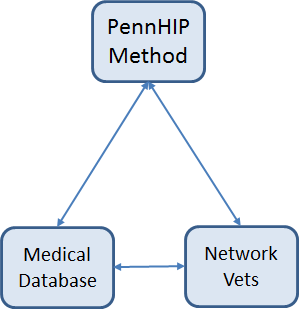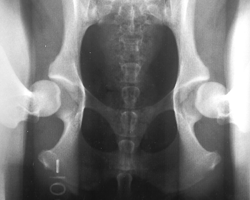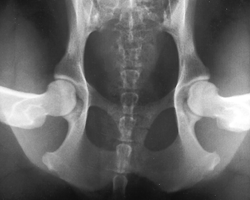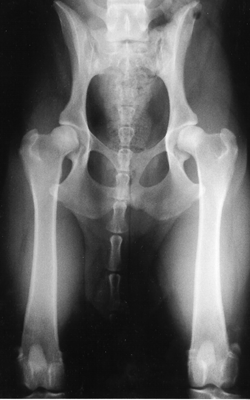What is PennHIP
What is PennHIP?
PennHIP is a multifaceted radiographic screening method for hip evaluation.
The technique assesses the quality of the canine hip and quantitatively measures canine hip joint laxity. The PennHIP method of evaluation is more accurate than the current standard in its ability to predict the onset of osteoarthritis (OA). Osteoarthritis, also known as degenerative joint disease (DJD), is the hallmark of canine hip dysplasia (CHD). It causes pain and disability in dogs who have it.
PennHIP is more than just a radiographic technique. It is also a network of veterinarians trained to perform the PennHIP methodology properly. Perhaps most importantly, it is a large scientific database that houses the PennHIP data. Radiographs are made by certified PennHIP members worldwide and the images are sent to the PennHIP Analysis Center for evaluation. The resulting data is stored in the database, which is continually monitored as it expands. As more information becomes available, the PennHIP laboratory is able to obtain more precise answers to questions about the etiology, prediction and genetic basis of hip dysplasia.
PennHIP publishes its findings in scientific journals. Published information is disseminated to all PennHIP members; it is also shared with interested breed clubs and routinely appears in publications within the dog fancy.

As the illustration above shows, PennHIP is composed of three major components:
- A diagnostic radiographic technique
- A network of trained veterinarians
- A medical database for scientific analysis
PennHIP at a Glance
The PennHIP method is a novel way to assess, measure and interpret hip joint laxity. It consists of three separate radiographs: the distraction view, the compression view and the hip-extended view. The distraction view and compression view are used to obtain accurate and precise measurements of joint laxity and congruity, respectively. The hip-extended view, sometimes called the OFA view, is used to obtain supplementary information regarding the existence of osteoarthritis (OA) of the hip joint. The singular, subjectively scored, hip-extended radiograph is the conventional radiographic view used by all hip screening systems globally to evaluate the integrity of the canine hip joint. The PennHIP technique is more accurate than this current standard, and it has been shown to be a better predictor for the onset of OA.
The radiographs pictured here are of the same dog, yet the hip joint laxities in each view look very different. Notice that the hips in the distraction view with the hips positioned in a neutral weight-bearing orientation appear to be much looser than they do in the hip-extended view.

Distraction View

Compression View

Hip-Extended View
The obvious contrast in joint laxity between the distraction and hip-extended views demonstrates the fundamental difference between the two radiographs. The looser the joint on the distraction view, the greater is the chance that the hip will develop OA. The hip-extended view tends to mask true hip joint laxity because the joint capsule is wound up into a tightened orientation when the hips are extended. This explains why measurable joint laxity on the distraction view is always greater than the measurable laxity from the hip-extended view. In fact, distraction laxity is up to 11 times greater depending on the breed of dog under study.
The compression view is used to determine the “goodness of fit” of the femoral heads into the acetabula. In a hip with OA, the remodeling that occurs in the acetabulum and/or the femoral head will often result in an ill-fitting “ball” and “socket”.
To summarize, the PennHIP method:
- Obtains OA readings from the standard hip-extended view
- Obtains hip joint congruity readings from the compression view
- Obtains quantitative measurements of hip joint laxity from the distraction view

A Brief History
In 1983, Dr. Gail Smith, a Professor at the University of Pennsylvania School of Veterinary Medicine, conceived and developed a new scientific method for the early diagnosis of canine hip dysplasia. Research conducted in his laboratory proved the diagnostic method to be capable of estimating the susceptibility for CHD in dogs as young as sixteen weeks of age. In 1993, Dr. Smith established PennHIP, a cooperative scientific initiative, to serve as a multi-center clinical trial of the new hip dysplasia diagnostic technology. In 2013 PennHIP was acquired from the University of Pennsylvania by ANTECH Diagnostics, Inc, of Los Angeles, CA.
